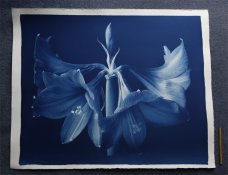- Joined
- Mar 8, 2012
- Messages
- 1
- Format
- Multi Format
Hello all,
Having a very narrow understanding of the chemistry and behavior of the cyanotype process, I have been trying to develop a way of deploying cyanotype chemicals on large surfaces (walls, floors, ceilings) with varying textures and materials in order to capture an "image" of the lighting conditions and objects and shadows within a space on its surfaces.
My question is how would one go about mixing the chemicals into some sort of paint or binding material that enables the chemicals to be rolled or painted on in a short period of time? I have done some tests with mixing things like corn starch into the basic cyanotype mix as a way of making it more capable of applique on surfaces that are not inherently absorbent like paper and cloth, but have had very blotchy and inconsistent coverage and results.
The issue of consistency and coverage points me to something like paint which covers surfaces relatively uniformly.
I am going to try to us gelatin as a "base coat" before rolling on the liquid solution, which I hope will allow to chemicals to adhere to surfaces and still be reactive, but also want to try using the cyanotype chemicals as a sort of additive pigment to normal paint. Will the paint retard the effectiveness of the chemicals? Will I need any other additives to allow the chemicals to still develop while being embedded in the paint?
Thanks!
Mark
Having a very narrow understanding of the chemistry and behavior of the cyanotype process, I have been trying to develop a way of deploying cyanotype chemicals on large surfaces (walls, floors, ceilings) with varying textures and materials in order to capture an "image" of the lighting conditions and objects and shadows within a space on its surfaces.
My question is how would one go about mixing the chemicals into some sort of paint or binding material that enables the chemicals to be rolled or painted on in a short period of time? I have done some tests with mixing things like corn starch into the basic cyanotype mix as a way of making it more capable of applique on surfaces that are not inherently absorbent like paper and cloth, but have had very blotchy and inconsistent coverage and results.
The issue of consistency and coverage points me to something like paint which covers surfaces relatively uniformly.
I am going to try to us gelatin as a "base coat" before rolling on the liquid solution, which I hope will allow to chemicals to adhere to surfaces and still be reactive, but also want to try using the cyanotype chemicals as a sort of additive pigment to normal paint. Will the paint retard the effectiveness of the chemicals? Will I need any other additives to allow the chemicals to still develop while being embedded in the paint?
Thanks!
Mark




